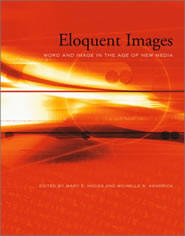
Home / Introduction / Part I / Part II / Part III / Part IV / Conclusion

I. Visual and Verbal Practices in New Media
Ch. 1 "Critical Theory and the Challenge of New Media." (top)
Jay David Bolter
Bolter gives an overview of how the present discussion of visual digital media's challenge to the status of print has come about in the field of humanities, specifically pointing to cultural studies. In doing so, he questions critical theory in academia and outlines common reactions and attitudes. By looking to examples from past practices and theories, he explains that "the gap between media theory and the cultural practices that surround new media forms has grown wide" and questions whether or not theory, then, can critique practice (p. 24). From here, Bolter explores the tension between theory and practice, particularly with a discussion of the pragmatic attitude towards education.
In a section titled, "Design in Context," Bolter provides examples from his own pedagogical practices and those of his colleagues at Georgia Tech. These examples demonstrate an ongoing investigation into the relationship between media theory and practice, a relationship that needs to incorporate historical and cultural contexts. Within this discussion, he defines his view of remediation, that is, the belief that "new media forms define themselves by borrowing from and refashioning earlier forms in print, photography, radio, film, and television" (p. 28). His belief in remediation serves as support for many of the other essays in the book and offsets the common view that new media can be defined as a revolution which implies that new media is original rather than borrowed and refashioned. Because Bolter sees the importance of looking at new media is this light, he is able to conclude that theory must not be divorced from design.
Ch. 2 "Seriously Visible." (top)
Anne Frances Wysocki
Specifically naming Habermas (1989) and Virilio (1994), Wysocki sets out to counter two assumptions common in new media studies, two assumptions that posit "visual texts make reading easy, that they predigest meaning, or that they make for standardized opinions and behaviors" (p. 56). Wysocki demonstrates the complicated requirements of interpretation of multimedia texts in order to question the assumption that hypertext automatically renders readers more active and more critical, an assumption that she recognizes has not gone unnoticed by new media critics. To do so, she presents two rhetorical analyses of two multimedia texts, Scrutiny in the Great Round and Throwing Apples at the Sun, and through this analysis, she is able to conclude that readers have to work to "apply abilities and approaches and understanding from rhetoric and art and visual communication and philosophy and critical theory" while they interpret (p. 56). In the end, Wysocki suggests that there is a tension between means and ends which points out the very complex nature of composing and interpreting multimedia texts. And, with a call to action, she suggests that rather than believe such multimedia texts will make readers more active and critical, we should believe in working together to make more complex texts and to develop the abilities to interpret them.
Ch. 3 "The Dialogics of New Media: Video, Visualization, and Narrative in Red Planet: Scientific and Cultural Encounters with Mars." (top)
Helen Burgess, Jeanne Hamming, and Robert Markley
This chapter complements the first two chapters in the book by presenting a case study of information architecture and theory in the creation of the DVD-ROM, Red Planet: Scientific and Cultural Encounters with Mars. Burgess, Hamming, and Markley's essay outlines the challenges the group had to face while developing this project in an environment of changing technologies. As a result, the authors explain how their cross-disciplinary narrative evolved as a result of the changing technologies and how they answered questions of multimedia in their production and design.
First, the authors of this essay explicate their consideration of language and media theory and the works of Mikhail Bahktin, Michel Serres, Jay David Bolter and Richard Grusin. In developing the DVD-ROM, the authors note, they particularly drew from Bolter and Grusin's theory of remediation because they recognized that "multimedia transforms and recombines local, discrete elements, remediating previous technologies of representation" (p. 66). Working from there, the project began to take shape and more composing decisions had to be made, composing decisions that demonstrate the complicated relationship between design and content and the dialogic nature of multimedia. For instance, the authors note the incorporation of video interviews into their DVD-ROM as an example. While the group wanted to incorporate the video interviews, they did not want to hinder the narrative. Ultimately, the group decided to arrange the interviews so that viewers could construct their own narratives of them. In the end, the authors contend that the way we interpret and create meaning with new media is complex and dialogic.Home / Introduction / Part I / Part II / Part III / Part IV / Conclusion